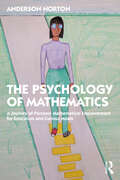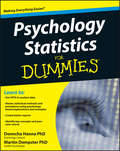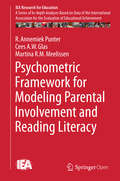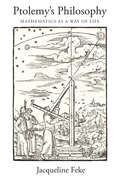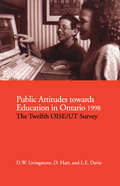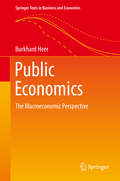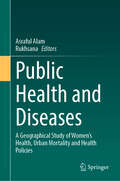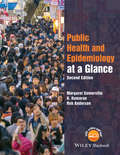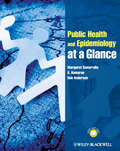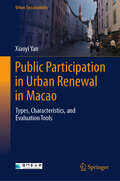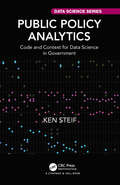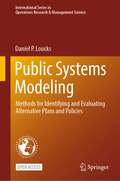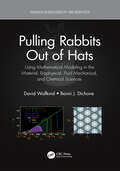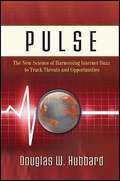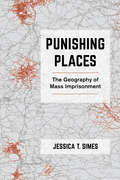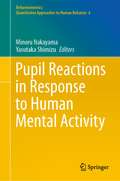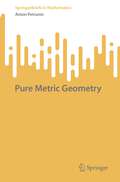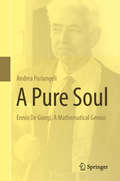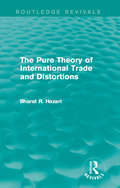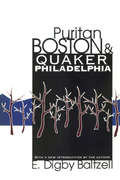- Table View
- List View
The Psychology of Mathematics: A Journey of Personal Mathematical Empowerment for Educators and Curious Minds
by Anderson NortonThis book offers an innovative introduction to the psychological basis of mathematics and the nature of mathematical thinking and learning, using an approach that empowers students by fostering their own construction of mathematical structures. Through accessible and engaging writing, award-winning mathematician and educator Anderson Norton reframes mathematics as something that exists first in the minds of students, rather than something that exists first in a textbook. By exploring the psychological basis for mathematics at every level—including geometry, algebra, calculus, complex analysis, and more—Norton unlocks students’ personal power to construct mathematical objects based on their own mental activity and illustrates the power of mathematics in organizing the world as we know it. Including reflections and activities designed to inspire awareness of the mental actions and processes coordinated in practicing mathematics, the book is geared toward current and future secondary and elementary mathematics teachers who will empower the next generation of mathematicians and STEM majors. Those interested in the history and philosophy that underpins mathematics will also benefit from this book, as well as those informed and curious minds attentive to the human experience more generally.
Psychology Statistics For Dummies
by Donncha Hanna Martin DempsterThe introduction to statistics that psychology students can't afford to be withoutUnderstanding statistics is a requirement for obtaining and making the most of a degree in psychology, a fact of life that often takes first year psychology students by surprise. Filled with jargon-free explanations and real-life examples, Psychology Statistics For Dummies makes the often-confusing world of statistics a lot less baffling, and provides you with the step-by-step instructions necessary for carrying out data analysis.Psychology Statistics For Dummies:Serves as an easily accessible supplement to doorstop-sized psychology textbooksProvides psychology students with psychology-specific statistics instructionIncludes clear explanations and instruction on performing statistical analysisTeaches students how to analyze their data with SPSS, the most widely used statistical packages among students
The Psychology Student’s Career Survival Guide: Here Be Dragons
by Alex ForsytheThe Psychology Student’s Career Survival Guide is designed to aid students in identifying their ideal career pathway and imbue them with the right tools and skills to not only achieve their desired job but to progress and thrive within the workplace. The first half of the book focuses on how to find and get a suitable job. The remaining chapters explore gaining success in the workplace in terms of personal growth, navigating criticism, workplace relations and the critical job assignments that every graduate should pursue. Forsythe, an experienced organisational psychologist, helps students recognise and apply the acquired psychological skill set to develop a personal brand, increase personal visibility and develop professional networks. This smooths the transition from university into the world of work by developing effective working practices that will support personal performance and that of the workplace. This book can also serve as a practical guide for academics looking to bridge the gap between the developing student at university and demands of their future employers. It explicitly calls for vocational elements such as communication, team-working, goal setting and planning within the curriculum. This engaging book comes with an abundance of resources to support students' individual development and to help academics run workshops. These resources include tool kits which include self-diagnostic tools and strengths finders, networking skill development, job search strategies, difficult interview questions, personal branding and so on. This is an essential text for psychology students at all levels looking for employability guidance and for psychology academics who are seeking supportive resources and guidance on helping students achieve their career ambitions.
Psychometric Framework for Modeling Parental Involvement and Reading Literacy
by Annemiek Punter Cees A. W. Glas Martina R. M. MeelissenThis volume offers insights from modelling measures of parental involvement and their relationship with student reading literacy across countries, exploring and incorporating cultural differences. This is a significant contribution to a field where cross-cultural comparisons from a triangulated perspective are sparse. For readers interested in exploring the relationship between parental involvement and student attainment, the literature review provides a useful starting point. Meanwhile, for the more methodologically interested reader, this report presents state-of-the-art ways to identify and model cultural differential item functioning in international large-scale assessment (ILSA), illustrating the extent to which the parental involvement construct may be influenced by cultural differences and how this may affect the outcomes of cross-cultural comparisons. The framework is generic and should provide a solid foundation for future ILSA practices and secondary analyses. ILSA studies like the IEA's Progress in International Reading Literacy Study (PIRLS) provide valuable data, containing both student achievement data and contextual background data from schools, teachers, students and parents for over 41 countries.
Ptolemy's Philosophy: Mathematics as a Way of Life
by Jacqueline FekeThe Greco-Roman mathematician Claudius Ptolemy is one of the most significant figures in the history of science. He is remembered today for his astronomy, but his philosophy is almost entirely lost to history. This groundbreaking book is the first to reconstruct Ptolemy’s general philosophical system—including his metaphysics, epistemology, and ethics—and to explore its relationship to astronomy, harmonics, element theory, astrology, cosmology, psychology, and theology.In this stimulating intellectual history, Jacqueline Feke uncovers references to a complex and sophisticated philosophical agenda scattered among Ptolemy’s technical studies in the physical and mathematical sciences. She shows how he developed a philosophy that was radical and even subversive, appropriating ideas and turning them against the very philosophers from whom he drew influence. Feke reveals how Ptolemy’s unique system is at once a critique of prevailing philosophical trends and a conception of the world in which mathematics reigns supreme.A compelling work of scholarship, Ptolemy’s Philosophy demonstrates how Ptolemy situated mathematics at the very foundation of all philosophy—theoretical and practical—and advanced the mathematical way of life as the true path to human perfection.
Public Attitudes Towards Education in Ontario, 1998:
by Lynn E. Davie D. Hart D. W. LivingstoneSince 1978, the OISE/UT Survey has been the only extensive analysis of public concerns about educational issues in Canada to be published on a regular basis. The survey profiles current patterns and trends in public opinion about policy options for all levels of education.The twelfth survey is based on interviews conducted in late 1998 with a random sample of 1000 Ontario adults, and questionnaires completed by over 100 randomly selected corporate executives. Trends in attitude changes are presented for the general public and executives. This survey focuses on public support for educational funding and major school governance and programme reforms, as well as the roles of universities and provisions for life-long learning in an emerging knowledge society.The goal of the OISE/UT surveys is to enhance public awareness of educational issues and to encourage informed participation in policy making. Timely, revealing, and easy to read, the survey is recommended for educators at all levels, policy-makers, and the general public.
Public Economics: The Macroeconomic Perspective (Springer Texts in Business and Economics)
by Burkhard HeerToday, the most pressing challenges for public economics are of macroeconomic nature: pensions, debt, income distribution, and fiscal sustainability. All these problems are compounded by the phenomenon of demographic transition and aging. This graduate textbook addresses these issues with the help of state-of-the-art macroeconomic tools that are based on a sound microfoundation and rooted in empirical evidence. Different from the standard partial-equilibrium analysis in traditional textbooks on public economics, the concept of general equilibrium helps to account for compensating or amplifying side-effects of economic policy. GAUSS and MATLAB computer code as well as teaching material (slides) are available as downloads from the author's homepage.
Public Health and Diseases: A Geographical Study of Women's Health, Urban Mortality and Health Policies
by Rukhsana Asraful AlamThis book provides a multi-disciplinary exploration of gender, public health, and disease with a focus on urban areas impacted by climate change. In three sections, global case studies are provided that analyze health risk management strategies in vulnerable populations containing high rates of mortality and disease morbidity. The sections are broadly divided along the themes, of women's health and gendered health challenges, demographic health issues such as aging populations, and the impacts of urbanization on health and the strategies to improve public health in urban areas such as green space projects. The book will be useful resource for students and researchers of health geography and public health, as well as public health practitioners and policymakers.
Public Health and Epidemiology at a Glance
by Margaret Somerville K. Kumaran Rob AndersonThis brand new title in the market-leading at a Glance series provides a highly-illustrated, visual introduction to the key concepts of population-level disease prevention. Accessible, double-page spreads help you understand and appreciate the determinants of health which impact on healthcare services and their effectiveness. Public Health and Epidemiology at a Glance features high-yield information on all the topics covered at medical school, including: Measurement of population health Epidemiological concepts of cause and association, surveillance, and risk Use of epidemiology in clinical decision-making Epidemiology of major health problems such as cardiovascular disease and cancer Health promotion Basics of health economics Basics of health policy, needs assessment, and evaluation Also featuring self-assessment questions to help test learning, this new title will provide an invaluable resource for medical and healthcare students, junior doctors, and those preparing for a career in public health.
Public Health and Epidemiology at a Glance (At a Glance #72)
by Margaret Somerville K. Kumaran Rob AndersonThis brand new title in the market-leading at a Glance series provides a highly-illustrated, visual introduction to the key concepts of population-level disease prevention. Accessible, double-page spreads help you understand and appreciate the determinants of health which impact on healthcare services and their effectiveness. Public Health and Epidemiology at a Glance features high-yield information on all the topics covered at medical school, including: Measurement of population health Epidemiological concepts of cause and association, surveillance, and risk Use of epidemiology in clinical decision-making Epidemiology of major health problems such as cardiovascular disease and cancer Health promotion Basics of health economics Basics of health policy, needs assessment, and evaluation Also featuring self-assessment questions to help test learning, this new title will provide an invaluable resource for medical and healthcare students, junior doctors, and those preparing for a career in public health.
Public Participation in Urban Renewal in Macao: Types, Characteristics, and Evaluation Tools (Urban Sustainability)
by Xiaoyi YanThis book analyses of public participation in the different development stages of urban renewal in Macao. Three types of participation are summarized from practice, analyzed their characteristics. And then develops a framework and a set of standards of participation quality evaluation that are applicable to Macao. Through a case study of public consultation meeting on Macao Urban Renewal Legal System, the participation quality of government-led public participation was evaluated. Finally, the applicability of the evaluation framework and standards was discussed. This book enriches the existing theories, and it provides new experience and the cases of public participation in urban renewal. Public participation in a new local context with multicultural and strong social connections was discussed. It builds the systems theoretical foundation on this field in Macao. It is a useful book for graduate students and the researcher in the academic field of urban renewal or urban governance to understand the public participation in urban renewal theory. This book can provide references for the government, associations, and private individuals to initiate and carry out public participation activities. It could provide decision-makers and researchers in Macao a reference for the quality evaluation of public participation.
Public Policy Analytics: Code and Context for Data Science in Government (Chapman & Hall/CRC Data Science Series)
by Ken SteifPublic Policy Analytics: Code & Context for Data Science in Government teaches readers how to address complex public policy problems with data and analytics using reproducible methods in R. Each of the eight chapters provides a detailed case study, showing readers: how to develop exploratory indicators; understand ‘spatial process’ and develop spatial analytics; how to develop ‘useful’ predictive analytics; how to convey these outputs to non-technical decision-makers through the medium of data visualization; and why, ultimately, data science and ‘Planning’ are one and the same. A graduate-level introduction to data science, this book will appeal to researchers and data scientists at the intersection of data analytics and public policy, as well as readers who wish to understand how algorithms will affect the future of government.
Public Relations: A Values-Driven Approach
by David W. Guth Charles MarshAn introduction to Public Relations that focuses on ethical, productive relationships with strategic constituencies Public Relations: A Values-Driven Approach introduces students to public relations, defined as the management of relationships between an organization and the publics important to its success. Authors David Guth and Charles Marsh outline the profession’s common issues, trends, and techniques, and help students to place the profession within the context of its role in the conduct of a civil society. In order to help students understand the contemporary state of the field, the Sixth Edition offers the most up-to-date statistics, the latest research, and the most current examples of public relations practice.
Public Systems Modeling: Methods for Identifying and Evaluating Alternative Plans and Policies (International Series in Operations Research & Management Science #318)
by Daniel P. LoucksThis is an open access book discusses readers to various methods of modeling plans and policies that address public sector issues and problems. Written for public policy and social sciences students at the upper undergraduate and graduate level, as well as public sector decision-makers, it demonstrates and compares the development and use of various deterministic and probabilistic optimization and simulation modeling methods for analyzing planning and management issues. These modeling tools offer a means of identifying and evaluating alternative plans and policies based on their physical, economic, environmental, and social impacts. Learning how to develop and use the mathematical modeling tools introduced in this book will give students useful skills when in positions of having to make informed public policy recommendations or decisions.
La puerta equivocada: Una nueva entrada al parque de diversiones de la matemática
by Adrián PaenzaEstrategia, intuición, deportes y juegos son algunos de los caminos que recorreremos en este nuevo libro del mejor divulgador de matemática del mundo. ¿Qué concepto tendríamos de la matemática si al ser niños en vez de hacer fracciones nos hubieran incentivado a pensar, por ejemplo, cuántos cromos habría que comprar para completar el álbum del Mundial o por qué la cola de al lado siempre se mueve más rápido que la nuestra? Como dice Adrián Paenza, entramos a la matemática por la puerta equivocada, y hay que transmitir que esta ciencia es maravillosa. Por eso, este libro es una invitación a encontrar esta nueva entrada y disfrutar de la belleza de la matemática, que nos enseña a observar y analizar de forma distinta nuestra vida cotidiana. Este libro te demostrará cómo entre todos podemos adivinar el peso de un toro, cómo podemos deducir si una jugada fue córner o saque de puerta, cuántas caras de un dado se pueden ver al mismo tiempo o cómo hace Netflix para predecir qué película elegiremos.
Pulling Rabbits Out of Hats: Using Mathematical Modeling in the Material, Biophysical, Fluid Mechanical, and Chemical Sciences (Advances in Biochemistry and Biophysics)
by David Wollkind Bonni J. DichonePulling Rabbits Out of Hats: Using Mathematical Modeling in the Material, Biophysical, Fluid Mechanical, and Chemical Sciences focuses on those assumptions made during applied mathematical modeling in which the phenomenological data and the model predictions are self-consistent. This comprehensive reference demonstrates how to employ a variety of mathematical techniques to quantify a number of problems from the material, biophysical, fluid mechanical, and chemical sciences. In doing so, methodology of modelling, analysis, and result generation are all covered. Key Features: Includes examples on such cases as solidification of alloys, chemically-driven convection of dissociating gases, temperature-dependent predator-prey mite systems, multi-layer and two-phase fluid phenomena, viral-target cell interactions, diffusive and gravitational instabilities, and chemical, material science, optical, and ecological Turing patterns. Aims to make the process of quantification of scientific phenomena transparent. Is a hybrid semi-autobiographical account of research results and a monograph on pattern formation. This book is for everyone with an interest in how both scientific contributions are made and mathematical modelling is developed from first principles in STEM fields. For errata, please visit the author's website.
Pulse
by Douglas W. HubbardThe ultimate guide to mining the Internet for real-time assessment of trends and dataShowing how the Internet can be an incredible tool for businesses and others to measure trends in real time, Pulse describes tools for inexpensive and real time measurement methodologies businesses can start using right away. This timely book also puts this emerging science in perspective and explains how this new measurement instrument will profoundly change decision making in business and government.Shows how the Internet can be used as an incredibly powerful measurement toolReveals how to mine the Internet to measure and forecast business progressWritten by leading expert in business analytics and performance managementPulse reveals how the Internet is evolving into a tool for measuring and forecasting trends in society, the economy, public opinion and even public health and security. It is an absolutely essential book for every business leader to turn a powerful, underutilized tool to its complete potential.
Pumpkin Countdown
by Joan Holub Jan SmithIn this rhyming picture book, a classroom of children goes on a field trip to the pumpkin patch, where they count everything in sight. The book is perfect for the fall season, and an extra-fun way to teach children to count backward from twenty.This is a fixed-format ebook, which preserves the design and layout of the original print book.
Punishing Places: The Geography of Mass Imprisonment
by Jessica T. SimesPunishing Places applies a unique spatial analysis to mass incarceration in the United States. It demonstrates that our highest imprisonment rates are now in small cities, suburbs, and rural areas. Jessica Simes argues that mass incarceration should be conceptualized as one of the legacies of U.S. racial residential segregation, but that a focus on large cities has diverted vital scholarly and policy attention away from communities affected most by mass incarceration today. This book presents novel measures for estimating the community-level effects of incarceration using spatial, quantitative, and qualitative methods. This analysis has broad and urgent implications for policy reforms aimed at ameliorating the community effects of mass incarceration and promoting alternatives to the carceral system.
Pupil Reactions in Response to Human Mental Activity (Behaviormetrics: Quantitative Approaches to Human Behavior #6)
by Minoru Nakayama Yasutaka ShimizuThis book focuses on a development for assessing mental changes using eye pupil reactions, namely extracting emotional change from the response to evaluate the viewer's interest in visual information. The pupil of the eye reacts to both brightness and emotional state, including interest, enjoyment, and mental workload. Because pupillary change is a biological signal, various artifacts influence measurements of eye images. Technical procedures are required to extract mental activities from pupillary changes, and they are summarized here step by step, although some procedures contain earlier techniques such as analog video processing. This study examines the possibility of estimating the viewer's interest and enjoyment of viewing movies by measuring the dynamic pupillary changes, blinking, and subjective interest responses. In evaluation of pupil size, there was a significant difference in pupil size between the higher and the lower shot for the degree of subject interest response in each kind of movies. The first part of the book shows a pupil reaction model for brightness changes to extract mental activities. Pupil reactions were observed for various visual stimuli in brightness changes. With regard to the characteristics of pupillary changes, a model with a three-layer neural network was developed and the performance was evaluated. Characteristics of pupil reactions during model development are summarized here. The second part examines the possibility of estimating the viewer's interest and enjoyment of television programs by measuring dynamic pupillary changes, blinking, and subjective interest responses. The final part describes a development of estimation model of pupil size for blink artifact. The model development was able to estimate pupillary changes and pupil size while the viewer was blinking and was applied to pupillary changes in viewing television programs.
Pure Metric Geometry (SpringerBriefs in Mathematics)
by Anton PetruninThis book serves as an introductory asset for learning metric geometry by delivering an in-depth examination of key constructions and providing an analysis of universal spaces, injective spaces, the Gromov-Hausdorff convergence, and ultralimits. This book illustrates basic examples of domestic affairs of metric spaces, this includes Alexandrov geometry, geometric group theory, metric-measure spaces and optimal transport.Researchers in metric geometry will find this book appealing and helpful, in addition to graduate students in mathematics, and advanced undergraduate students in need of an introduction to metric geometry. Any previous knowledge of classical geometry, differential geometry, topology, and real analysis will be useful in understanding the presented topics.
A Pure Soul: Ennio De Giorgi, A Mathematical Genius
by Andrea ParlangeliThis biography illuminates the life of Ennio De Giorgi, a mathematical genius in parallel with John Nash, the Nobel Prize Winner and protagonist of A Beautiful Mind. Beginning with his childhood and early years of research, into his solution of the 19th problem of Hilbert and his professorship, this book pushes beyond De Giorgi’s rich contributions to the mathematics community, to present his work in human rights, including involvement in the fight for Leonid Plyushch’s freedom and the defense of dissident Uruguayan mathematician José Luis Massera. Considered by many to be the greatest Italian analyst of the twentieth century, De Giorgi is described in this volume in full through documents and direct interviews with friends, family, colleagues, and former students.
The Pure Theory of International Trade and Distortions (Routledge Revivals)
by Bharat HazariFirst published in 1978. This book provides a simple, systematic, yet rigorous treatment of the key aspects of the pure theory of international trade and distortions. The opening chapter presents the standard two-factor, two-commodity barter model of international trade and a comprehensive treatment of the important properties and relationships. The rest of the book consists of four sections: parts One and Two are devoted to an analysis of factor market imperfections, and Parts Three and Four consider the trade-theoretical consequences of product market imperfections. A concluding chapter presents some generalised theorems. This book would be of interest to students of economics.
Puritan Boston and Quaker Philadelphia
by E. Digby BaltzellBased on the biographies of some three hundred people in each city, this book shows how such distinguished Boston families as the Adamses, Cabots, Lowells, and Peabodys have produced many generations of men and women who have made major contributions to the intellectual, educational, and political life of their state and nation. At the same time, comparable Philadelphia families such as the Biddles, Cadwaladers, Ingersolls, and Drexels have contributed far fewer leaders to their state and nation. From the days of Benjamin Franklin and Stephen Girard down to the present, what leadership there has been in Philadelphia has largely been provided by self-made men, often, like Franklin, born outside Pennsylvania.Baltzell traces the differences in class authority and leadership in these two cites to the contrasting values of the Puritan founders of the Bay Colony and the Quaker founders of the City of Brotherly Love. While Puritans placed great value on the calling or devotion to one's chosen vocation, Quakers have always placed more emphasis on being a good person than on being a good judge or statesman. Puritan Boston and Quaker Philadelphia presents a provocative view of two contrasting upper classes and also reflects the author's larger concern with the conflicting values of hierarchy and egalitarianism in American history.
Puritan Boston and Quaker Philadelphia
by E. Digby BaltzellBased on the biographies of some three hundred people in each city, this book shows how such distinguished Boston families as the Adamses, Cabots, Lowells, and Peabodys have produced many generations of men and women who have made major contributions to the intellectual, educational, and political life of their state and nation. At the same time, comparable Philadelphia families such as the Biddles, Cadwaladers, Ingersolls, and Drexels have contributed far fewer leaders to their state and nation. From the days of Benjamin Franklin and Stephen Girard down to the present, what leadership there has been in Philadelphia has largely been provided by self-made men, often, like Franklin, born outside Pennsylvania.Baltzell traces the differences in class authority and leadership in these two cites to the contrasting values of the Puritan founders of the Bay Colony and the Quaker founders of the City of Brotherly Love. While Puritans placed great value on the calling or devotion to one's chosen vocation, Quakers have always placed more emphasis on being a good person than on being a good judge or statesman. Puritan Boston and Quaker Philadelphia presents a provocative view of two contrasting upper classes and also reflects the author's larger concern with the conflicting values of hierarchy and egalitarianism in American history.
